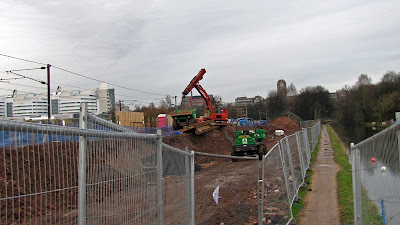Stratford Canal
1 June 2009
Update May 2011
During a recent trip along the Stratford Canal I picked up these extra images of this impressive aqueduct:
Edstone, sometimes referred to as the Bearley Aqueduct after the nearby village, is to be found on the Stratford Canal and holds the record as being the longest aqueduct in England.

The aqueduct was built in the early 1800's and spans a road and the Alcester Railway (now the Great Western Railway) via a 250 yard cast iron trough sitting atop 13 brick piers, which vary in height from eight to eleven metres. The channel itself is similar to that used at Longden upon Tern, with the towpath forming part of the baseplate.

A later picture of this water point reveals a heater at the bottom, used to prevent it freezing up in winter.
This structure is full of historical interest, and at one time was owned by the Great Western Railway, who fitted a pipe onto it an used it to refill the tanks of passing steam trains.
It also serves as a backdrop for one of the few photos of the infamous canoeist who purchased a solitary license in March 1953 and made a passage along the length of the canal over a series of chilly weekends, a purchase which saved the canal from abandonment. The rest is, as they say, history.

The trough was built without expansion joints, an omission which caused two cast iron plates to break apart and, over a period of 150 years to cause the end buttresses to start to move away from the embankments. The National Trust did a quick and dirty fix in the 1960's, welding a steel plate over the gap and building a concrete buttress to prop up each end. Sadly, these fixes ultimately did more harm than good, with impermeable layers preventing the escape of moisture and allowing the frost to inflict further structural damage.
A proper expansion joint was added in 1992 and then in 2003, some major remedial work was undertaken by Galliford Try. This involved removing the waterproof Gunnite from the buttresses, replacing the engineering bricks inserted into the piers and finally stripping all the lead paint off the cast iron trough before applying a new coat of paint. This £600,000 project was completed under a huge movable tent, without interrupting boat movements and was jointly funded by BW and the Hertitage Lottery Fund on a 7:5 split. Hopefully this investment will see the aqueduct carrying narrowboats in another 200 years time.












